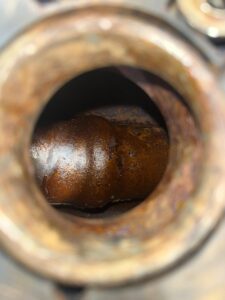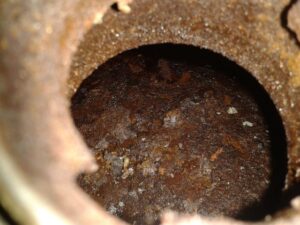If a gas tank has been sitting for an extended period of time, it’s important to clean it before using it again to prevent any issues with the fuel system.
Are you dealing with a rusty gas tank? Checkout the full guide below!
How to clean a gas tank that has been sitting
- First, remove the gas tank from the vehicle and place it on a stable, flat surface.
- Use a socket wrench to remove the fuel line and any other fittings or attachments from the tank.
- Using a gas tank cleaner solution, carefully pour the cleaner into the tank through the fuel filler neck. Follow the instructions on the cleaner for the recommended amount to use.
- Once the cleaner has been added to the tank, use a long-handled brush to scrub the inside of the tank, paying special attention to any areas that may be particularly dirty or corroded.
- After scrubbing the tank, rinse it thoroughly with clean water to remove any remaining cleaner or debris.
- Once the tank is clean and dry, reattach the fuel line and any other fittings or attachments and reinstall it in the vehicle.
By following these steps, you can effectively clean a gas tank that has been sitting and ensure that it’s ready to use again. Just be sure to handle the cleaner and any other chemicals safely and to wear protective gear such as gloves and goggles to avoid any accidents.
What is the best way to clean an old gas tank?
There are a few steps you can take to effectively clean an old gas tank, similar to the above method:
- Remove the tank from the vehicle and place it on a stable, flat surface.
- Use a socket wrench to remove the fuel line and any other fittings or attachments from the tank.
- Using a gas tank cleaner solution, carefully pour the cleaner into the tank through the fuel filler neck. Follow the instructions on the cleaner for the recommended amount to use.
- Use a long-handled brush to scrub the inside of the tank, paying special attention to any areas that may be particularly dirty or corroded.
- Rinse the tank thoroughly with clean water to remove any remaining cleaner or debris.
- Once the tank is clean and dry, reattach the fuel line and any other fittings or attachments and reinstall it in the vehicle.
Using a gas tank cleaner solution is generally the most effective way to clean an old gas tank, as it can help to break up any dirt, grime, or debris that may be present in the tank.
What happens when gas sits in tank too long?
If gas sits in a tank for an extended period of time, it can begin to break down and degrade, which can lead to a number of problems. Here are a few things that can happen when gas sits in a tank for too long:
- The gas can become contaminated with water or other impurities, which can cause the engine to run poorly or not at all.
- The gas can begin to break down and form sludge or sediment, which can clog the fuel filter and fuel lines, leading to decreased performance and fuel efficiency.
- The gas can begin to evaporate, leaving behind a thicker, more concentrated liquid that can be difficult to use and may damage the fuel system.
To avoid these issues, it’s important to use gas within a reasonable amount of time and to keep the gas tank as full as possible to reduce the amount of air in the tank, which can cause the gas to break down more quickly. If you do need to store a vehicle for an extended period of time, it’s a good idea to add a fuel stabilizer to the gas to help prevent these problems.
How long can gasoline sit in a tank before it goes bad?
The amount of time that gasoline can sit in a tank before it goes bad depends on a number of factors, including the quality of the gasoline and the temperature at which it’s stored. In general, gasoline can last anywhere from three to six months before it begins to break down.
However, if the gasoline is stored in a hot environment, it can break down more quickly. Similarly, if the gasoline is of poor quality or contains ethanol, it may break down more quickly as well.
To help extend the shelf life of gasoline, it’s a good idea to store it in a cool, dry place and to keep the gas tank as full as possible to reduce the amount of air in the tank, which can cause the gas to break down more quickly. If you do need to store a vehicle for an extended period of time, it’s also a good idea to add a fuel stabilizer to the gas to help prevent degradation.
What to put in a gas tank that has been sitting?
If a gas tank has been sitting for an extended period of time, it’s a good idea to clean it before adding new gasoline. To do this, you can use a gas tank cleaner solution, which is specifically designed to break up dirt, grime, and other contaminants that may be present in the tank.
To use the cleaner, simply remove the gas tank from the vehicle and place it on a stable, flat surface. Use a socket wrench to remove the fuel line and any other fittings or attachments from the tank.
Then, carefully pour the cleaner into the tank through the fuel filler neck, following the instructions on the cleaner for the recommended amount to use. Use a long-handled brush to scrub the inside of the tank, paying special attention to any areas that may be particularly dirty or corroded.
Once you’ve finished scrubbing the tank, rinse it thoroughly with clean water to remove any remaining cleaner or debris. Once the tank is clean and dry, you can add new gasoline to the tank.
Just be sure to handle the cleaner and any other chemicals safely and to wear protective gear such as gloves and goggles to avoid any accidents.
Other cleaning guides
How To Clean A Synthetic Gun Stock (BEST METHOD)



